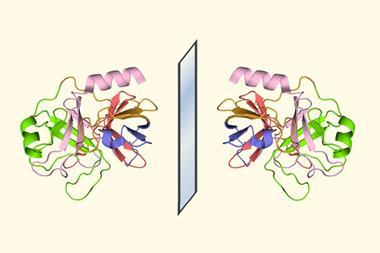The sophisticated chiral structures of proteins usually mean they can only interact with ligands with a complementary chirality. Now, researchers have observed that disorganised proteins and peptides have identical interactions with strings of L- and D-amino acids, which could have implications in drug discovery and help to uncover the causes of chirality on early Earth. ‘It is possible for a [disordered] protein to interact with its ligand regardless of its chirality,’ explains co-first author Estella Newcombe from the University of Copenhagen, Denmark.

Almost every natural protein consists of concatenations of L-amino acids. Once fully folded, the three-dimensional structure is stereospecific to a series of molecules, called ligands, normally left-handed in the case of small peptides. Therefore it was ‘assumed that a native L-protein [couldn’t] interact with its D-peptide ligand’, says Newcombe. ‘We showed that L- and D-proteins interact, if such interaction remains somewhat [disordered and] dynamic.’ However, as the protein structure became more ordered, the chance of recognising the mirror substrate decreased.
Nevertheless, an increasing number of disordered peptides and proteins have been discovered in recent years. ‘It’s increasingly apparent that a significant proportion of the proteome is disordered,’ explains Jane Clarke, an expert on protein folding at Wolfson College at the University of Cambridge, UK. Despite previous assumptions, some disorganised proteins ‘form specific and tight binding complexes’, although they are surprisingly ‘“blind” to specific structural signals’, she adds. ‘In many ways, this is baffling.’
In this study, researchers selected pairs of proteins and ligands, in which one of them stays disordered in the unbound state. By synthesising both L- and D-peptides and proteins, they could compare the compatibility in increasingly organised structures, and measure the binding strength, as well as the sensitivity to chirality. ‘The more ordered [the] structure … the less chance that a protein could interact with its mirror ligand,’ says Newcombe.

It’s a ‘remarkable way’ to test the stereospecificity of disorganised peptides and proteins, explains Clarke. Researchers made a ‘really clever choice of test systems, [supported by] the strength of a variety of tools to determine the structural and dynamic properties of proteins and complexes’.
‘There is a presumption that protein–protein interactions are stereospecific, but this shows that [some] interactions don’t appear to depend on chirality,’ says Michael Kay, an expert in mirror-image biology at the University of Utah, US. Whereas fully-folded proteins have just a small degree of flexibility, ‘disordered proteins adopt a diverse array of structures, more akin to strands of spaghetti’, adds Kay, or as one commenter dubbed them ‘floppy fuzzballs’. Here, if ‘both components of a complex [are] disordered, the heterochiral interaction [is] equivalent to the natural homochiral interaction’. In homochiral interactions, the two pieces at play have the same handedness.
The implications of the discovery transcend structural biology. This could advance the ‘design of drugs to target disordered proteins, central to many signalling processes in the cell, and thus central to understanding [several] disease systems’, explains Clarke. Because our bodies broadly metabolise L-peptides and proteins, understanding the subtleties of structural recognition of mirror molecules could convey creative solutions for targeted treatments. ‘D-peptides are invisible to degradation, thus more stable,’ adds Newcombe. Eventually, D-peptides and proteins might provide ‘a new avenue for targeting diseases caused by disordered proteins, [such as] neurodegenerative diseases’, she adds.
Moreover, ‘the authors intriguingly speculate that the heterochiral interactions observed could have existed in a prebiotic world, before homochirality was established’, says Kay. Such suppositions, alongside additional studies, could uncover clues towards clarifying key points in molecular evolution, including the dominance of left-handed amino acids, peptides and proteins. So far, it’s proven the possibility that protein–protein interactions existed on prebiotic Earth. But it raises questions too. Some evidence suggests that ‘both L- and D-amino acids were present before life started on Earth, however today … D-[residues] have become very rare’, says Newcombe. ‘Our study shows L- and D-[peptides and proteins] interact in certain conditions, so it really raises more questions: why did we end up with one enantiomer and not the other?’
References
EA Newcombe et al, Nature, 2024, DOI: 10.1038/s41586-024-08271-6

















No comments yet